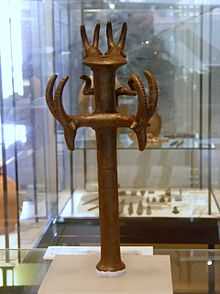Nahal Mishmar

Coordinates: 31°22′51.37″N 35°21′51.65″E / 31.3809361°N 35.3643472°E
Nahal Mishmar (Hebrew:נחל משמר; Arabic:مَحْرَس) is one of the smaller seasonal streams in the Judean Desert.
Geography
Nahal Mishmar begins in the Hebron hills, running east towards the Dead Sea. Its western part is shallow, at an altitude of approximately 270 m above sea level, and it proceeds to fall more than 300 meters into the Jordan Rift Valley before emptying into the Dead Sea, over 12 kilometres (7.5 mi). Nahal Mishmar runs north of the Tze'elim Stream, between Ein Gedi and Masada. Access is from Highway 90.
Archaeology
In 1961, Israeli archaeologist Pessah Bar-Adon discovered a hoard of Chalcolithic artifacts in a cave on the northern side of Nahal Mishmar.[1] The hoard included 432 copper, bronze, ivory and stone decorated objects; 240 mace heads, about 100 scepters, 5 crowns, powder horns, tools and weapons.[2][3] Archaeologist David Ussishkin has suggested the hoard was the cultic furniture of the abandoned Chalcolithic Temple of Ein Gedi.[4][5] Prominent finds from the hoard are currently on display in the archaeology wing of the Israel Museum in Jerusalem.
Dating; use of lost-wax process
Many of these copper objects were made using the lost-wax process, the earliest known use of this complex technique.
"Carbon-14 dating of the reed mat in which the objects were wrapped suggests that it dates to at least 3500 B.C. It was in this period that the use of copper became widespread throughout the Levant, attesting to considerable technological developments that parallel major social advances in the region."[6]
Some of the tools in the hoard were made of arsenical bronze, or perhaps arsenical copper. Since they contain a rather high percentage of arsenic (4–12%), they should technically be described as arsenical bronze; also such objects have a bright, silvery appearance. Arsenic in copper makes is harder than pure copper and more easily cast.
See also
References
- ↑ Bar-Adon, Pessah (1971). מערת המטמון, הממצאים מנחל משמר [The Cave of the Treasure: The Finds from the Caves in Nahal Mishmar] (in Hebrew). Jerusalem: The Bialik Institute and the Israel Exploration Society.
- ↑ "Diggers". Time magazine. May 5, 1961. Retrieved 2010-06-30.
- ↑ Shanks, Hershel (May–June 2008). "Ein Gedi's Archaeological Riches". Biblical Archaeology Review (Washington, D.C.: The Biblical Archaeology Society) 34 (3): 58–68.
- ↑ Usishkin, David (1971). "The "Ghassulian" Temple in Ein Gedi and the Origin of the Hoard from Nahal Mishmar". The Biblical Archaeologist (American Schools of Oriental Research) 34 (1): 23–39.
- ↑ Usishkin, David (1980). "The Ghassulian Shrine at En-gedi". Journal of the Tel Aviv University Institute of Archaeology 7 (1—2): 1–44. doi:10.1179/033443580788441071. ISSN 0334-4355.
- ↑ The Nahal Mishmar Treasure at Metropolitan Museum
External links
| Wikimedia Commons has media related to Nahal Mishmar Hoard. |
- The Nahal Mishmar Treasure at Metropolitan Museum